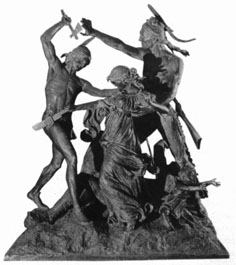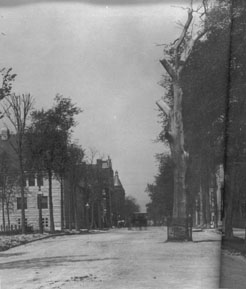|

 |
Monuments to a Lost Nationby Theodore J. Karamanski |
<Reprinted from Chicago History, Spring 2004>
The statue enjoyed great public recognition and acclaim. Former President Benjamin Harrison (grandson of former president and War of 1812 hero William Henry Harrison), Robert Todd Lincoln, and many of the city's meatpackers and merchandisers attended the dedication ceremony. The art critics of the time looked favorably upon the bronze, declaring: "It is one of the greatest pieces of realistic sculpture . . . in this or any other part of the world."
But the monument also contains a subversive quality. The hero of the group is not one of the representatives of white America but a member of the doomed race. The dominant image of the bronze is the ferocity of the Indians, shown to be overwhelming the civilized order, not an image in which a "robber baron" such as Pullman might take comfort as he looked out his library window. In
this sculpture, the myths and realities of the American frontier
collided with the anxieties
of an urban nation in social and economic conflict. The cultural
diversity,
economic stratification, and general instability of life in late
nineteenth century cities such as Chicago made many residents yearn
for an established order. Even while industrialists such as Pullman
used monuments to demonstrate how far the city had come in less
than a hundred years, Chicagoans had their own memories that underscored
how fragile and transitory such material progress could be. The
Great
Chicago Fire of 1871 had quickly swept away a large portion of
the city. The sudden panics and depressions of 1873 and 1890 wiped
out the fortunes of many men seemingly of substance. The Haymarket
Affair of 1886 revealed the depth of class resentment and the potential
for violence that simmered beneath the surface of Chicago. Pullman
and other members of the city's elite could look at the Fort Dearborn
Massacre as an "enduring monument" (according to the Chicago
Tribune) in a sea of troubled change, a social anchor. That Pullman
so quickly became disenchanted with the monument when the working
class appropriated its public space for its own purposes reveals
the degree to which he valued social control. This predilection was
best demonstrated, of course, in his model industrial town: Pullman,
where the industrialist's desire to control almost all aspects of
his workers' lives contributed to the violent 1894 strike that rocked
the entire nation.
Forward to the next page of this essay Back to the previous page Back to Online Essays |
| |
Department
of Anthropology |
copyright © 2002
University of Illinois, All rights reserved. |


